How to install 3 Android tablets in your car
I shoehorned three Nvidia Shield Tablets into my Jeep, and it's awesome
When I was growing up, my parents had an '84 Dodge Caravan and eventually upgraded to a 1998 Grand Caravan. I yearned for rear air conditioning and some form of entertainment, but got by with only music from a Walkman or Discman.
Rear seat entertainment (RSE) systems were only available on high-top conversion vans via CRT televisions and a VCR – a luxury I did not have as a child. But family road-trips were a rare occurrence for my childhood, so I kept myself entertained by staring aimlessly out the window with mixtapes recorded off the radio.
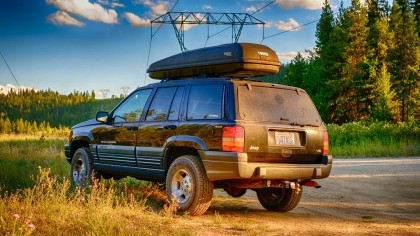
You can buy a new vehicle with integrated RSE systems, but they are costly. Take the Chrysler Pacifica minivan, for example. It's the newest family vehicle with a modern RSE that includes Blu-ray playback, touchscreen two-player games and HDMI input to bring your own devices, like an Xbox or Playstation.
Chrysler charges $2000 for the privilege of keeping your children entertained, but only makes it available on the top-end Limited trim that starts at $43,000 (not available in the UK or AU). The cost of Chrysler's Uconnect Theater RSE system seems excessive, especially since you can beat the function and capability of integrated systems with a couple tablets for a third the price.
Since I'm preparing my 1997 Jeep Grand Cherokee for long family road-trips, an RSE to keep my 5- and 3-year-old girls entertained is a must. So, a pair Android tablets are going on the rear seats to join my existing Shield Tablet LTE in the dashboard.
Shield Tablet K1 is perfect for RSE
You can use any iPad or Android tablet for RSE – it depends on the level of performance and capability you want. I opted for a pair of Nvidia Shield Tablet K1's for the front-facing speakers, Tegra K1 processor, Shield controller and pure Android experience.
As a geek and connoisseur of excessive capability for no reason, the Tegra K1 fits the bill for running Kodi, Netflix, Crossy Road, Pix the Cat and SNES emulators. However, it has performance headroom for the future and Nvidia has had a good track record of software updates through the tablet's lifetime.
Get daily insight, inspiration and deals in your inbox
Sign up for breaking news, reviews, opinion, top tech deals, and more.
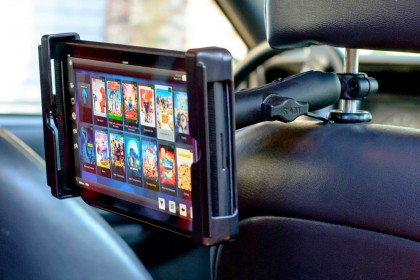
Aside from the basic video playback tasks, the Shield Tablet K1 tablets are configured to run ScummVM, a program that lets you run the classic Lucas Arts adventure games and the kid games from Humongous Entertainment. Growing up in the '90s, I remember playing games like Putt-Putt Goes to the Moon and Putt-Putt Saves the Zoo on my elementary school's Apple Performa 5200, which are games I want my own kids to experience.
Humongous Entertainment sells some of its '90's children games, including Putt-Putt, Freddi the Fish, Spy Fox and Pajama Sam, repackaged for Android on the Google Play Store, but it charges $4.99 for each individual game. There are 19 games for Android, which comes out close to $100, whereas I paid $40 during a Steam sale for the entire collection on PC.
Since the Steam versions run inside ScummVM, all the necessary files needed to run it on Android are available in the Windows install directory. I found a script on Reddit that automatically copies the files required from the Steam directories for ScummVM to run the games, which made things easier.
Secure mounting
My biggest concern with using tablets in a car for RSE is secure mounting solutions. Sure, the Shield Tablet K1 weighs a little under a pound, but it's a potential projectile during an accident. There are cheap $15 mounts that attach to your seat headrests, but they seem flimsy and I don't trust them.
In continuing with the tradition of overkill, I went to RAM Mounts in Seattle, Wash. to come up with a mounting solution for the Shield Tablet K1's. RAM Mounts produces secure mounting systems for laptops, tablets and phones, which are used by law enforcement, EMTs and other professionals, so its sufficient for a pair of toddlers.
The mounting solution devised consists of a RAM Mount Torque 3/8" – 5/8" diameter mini rail base, a six-inch arm and a Tab-Tite spring-loaded cradle. Cost for all the mounting parts came out to $70 per tablet, which is only a little more than what you pay for a rugged case for your phone.
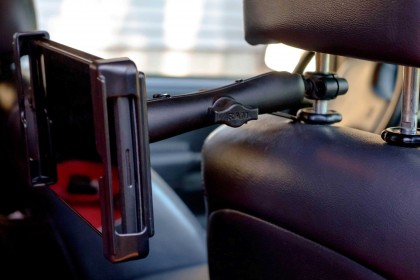
RAM Mount's Torque attaches to the headrest post and provides a ball mount to attach the arm on. The six-inch arm provides plenty of movement to bring the Shield Tablet K1 closer for my kids to use or easily move out of the way when not in use.
The Tab-Tite is a cradle designed for the Google Nexus 7 with a rugged case installed that fits a naked Shield Tablet K1 perfectly. It has a spring-loaded back plate that makes popping the tablet in and out quick and easy.
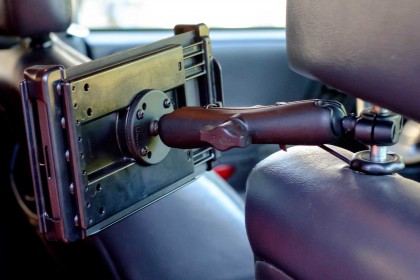
A bonus benefit is the Tab-Tite fits the Shield Tablet K1 with the official Nvidia cover still attached. This saves me the trouble of storing the covers when the tablets are installed in the car so I can just flip it backwards and slide it into the Tab-Tite.
Powering the tablets
I used the same E-Kylin right-angled micro USB chargers as the in-dash tablet to power the rear ones. I had to unzip the seat covers and run the cable through the seat and out through to the headrest post. Most cars have a zipper you can unzip to access the seat-foam area – it may take some finagling and patience.
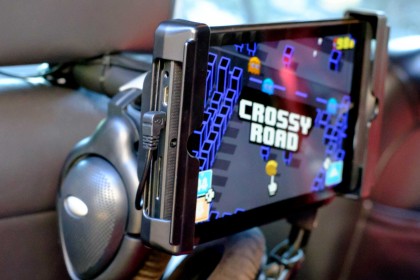
You could keep things simple by just using a 2.1-amp USB cigarette lighter charger, but I prefer hard-wired and hidden cabling. The power adapters are wired to a switched power source that only works when the ignition switch is on or in accessory mode.
Audio for the kids
While the Shield Tablet K1 has front-facing speakers that are perfectly adequate for watching movies and playing games, I don't want to hear The Lego Movie or Zootopia a bajillion times for my own sanity, so headphones are a must.
Standard wired headphones I had laying around are being used, for the time being. The wiring gets messy with the kids in the car seats, but it's a temporary solution until I get Bluetooth headphones.
I'm eying the Creative Labs Outlier Bluetooth headphones for this duty, since they're small enough to fit toddler ears and come in interchangeable colors. The Outliers are rechargeable, but still work when plugged in for those times I forget to charge them, too.
An 1,100-mile test run
My Jeep is being built for road-trips, so what better way to test the Shield Tablet infotainment system and Shield Tablet K1 RSE than a 7-hour road-trip? So, we packed our bags, loaded up the Thule roof box and hitched up a pop-up camper trailer and headed to Ione, Wash. – a small town along the Pend Oreille River that's about 30-miles south of the eastern Washington and Canadian border.
This was the first time I've taken the Jeep on a long road trip – previous drives were only about 2 hours to Portland, Ore. I discovered the in-dash Shield Tablet LTE developed some Bluetooth issues after I installed the Satechi Bluetooth media button and OBDII Bluetooth adapter.
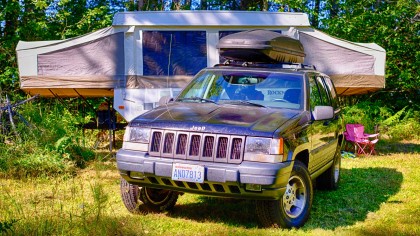
Audio pops and drops start occurring intermittently making it impossible to enjoy the music. It had troubles reconnecting to my Galaxy S7 via Wi-Fi, which I was using as a mobile hot spot. I believe the new Shield Tablet 4.2 OTA update contains fixes that should solve my issues, but the OTA wasn't available for the US LTE version yet, since it's awaiting carrier approval.
I didn't have time to flash the international firmware prior to the trip, unfortunately.
The Shield Tablet K1 RSE system was a hit with my two kids. My 5-year-old spent the trip playing Pajama Sam, Putt-Putt and Crossy Road with the occasional movie break while my 3-year-old watched a couple of movies and passed out.
Should you try this at home?
Installing a tablet in a car can be either very quick or all-too time consuming, depending on how you want it installed. It's not the most economical solution either, but I'm a geek and love tinkering.
You can make things work like a normal car stereo with the available hardware and software solutions. My Nvidia Shield Tablet setup would have cost around $900 if I had to buy everything, but if your car has an aux input and you don't mind suction cup tablet mounts, it shouldn't cost that much.
Would I have spent $900 to buy everything purely for a car install? The answer is no, but my Shield Tablet was collecting dust and I could detach my Sound Blaster E5 when I need to hop a flight, so I'm not losing much and the tablet gets used.
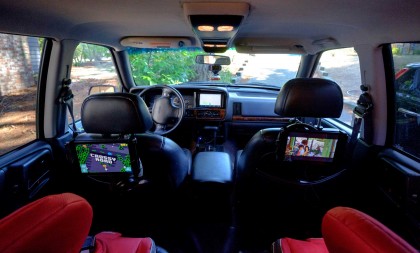
Plus, now I can play Doom 3, Borderlands: The PreSequel and classic SNES games in the car while waiting for my wife outside the craft store, which is pretty damn cool.
As for the RSE, it came out to about $600 for all the parts necessary to complete the installation. This was definitely worth it and a much better than opting for a factory-installed system.
Not only was it much more affordable than the $1,000-$2,000 automakers charge, it's a superior system in every way. The Shield Tablet K1 is more powerful than any factory RSE system offered. It only lacks an HDMI input, which isn't really needed.
With the cost difference, I could shoehorn an Alienware Alpha R2 in the back and use GeForce game-streaming for real PC gaming in the car, which gives me another idea…